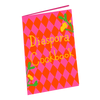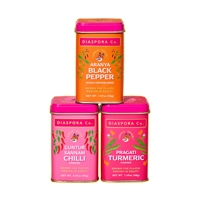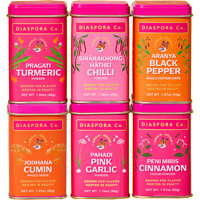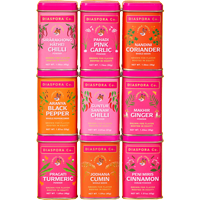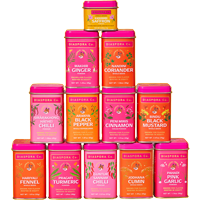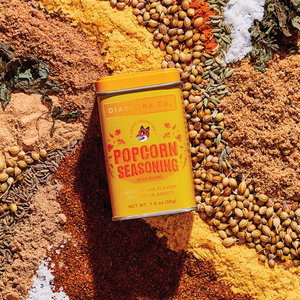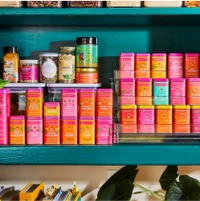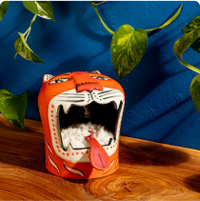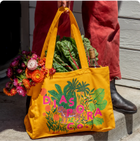Every day, in Khari Baoli, a bazaar in Shahjanabad or Old Delhi, sacks of spices arrive to be sent to the rest of India, and the world. Trade takes place amidst busy local crowds and overwhelmed tourists; cardamom from Kerala, turmeric pods from Meghalaya and figs from Afghanistan rub shoulders in the bazaar, which is the largest in South Asia. Right beside Khari Baoli is Bharat chai stall. Here, a handful of spices from the sacks is added to milk and tea leaves to brew hundreds of cups of masala chai. The chai is taken to porters, workers and sellers from Khari Baoli, who are served in small glass cups hinged onto steel holders. With lots of spices and sugar, the masala chai at Bharat’s is refreshing and filling, a comfort in both Delhi’s scorching summers and bone-breaking cold. “Ek cup chai may hi saari duniya ki chaal hai, dekh lo,” the man who runs the stall says about his tea. “Look inside, the paths of the world can be found inside this cup of chai.”
Like many chai stalls, Bharat’s selection and quantity of spices used depend on his whims, or their availability. But the stall is integral to Khari Baoli and Old Delhi, a junction for workers, friends, young couples and families alike. To customers, the chai is a break from their day; it carves out a window of time and a claim of space in the city that teems with millions at every nook.
Although it may seem like masala chai has always belonged to the Indian and South Asian culinary landscape, it has, in fact, taken many historical turns to arrive here.
From Ritual to Routine
Let’s rewind a bit to the 18th century. By this time, tea drinking had become a ritual among the British elite, who brewed it by letting leaves simmer in hot water in ceramic pots. It was accompanied by vivid ceremony — replete with cakes, desserts and the show of ceramics and wealth. Tea first came to the Indian subcontinent in 1823 as a plant to be produced for the British. The East India Company, which had begun to gain control of India’s markets, was looking to break the Chinese monopoly on the product that was widely consumed in their country. A tea plant similar to Chinese tea was found growing in Assam, which the British called Camellia Assamica. It produced a denser, darker brew than its Chinese counterpart. After the discovery, the first tea plantations in India were set up in Assam and Darjeeling in 1834, where sweeps of forest were razed to grow the plant, and indentured labourers from across the subcontinent were brought to work these lands. These workers were from indigenous and marginalised caste communities, and were subsequently called “tea-tribes”.
In 1849, the first shipment of tea was sent to London. By 1884, Indian tea had almost equaled Chinese tea in consumption, noted an article in the Daily News in July 1885. Colonialism created a brutally exploitative relationship between the Indian soil and British markets, whereby the subcontinent was used merely to satisfy whims, without consideration for the quality or nature of soil, or the communities that would tend to it. Many crops were grown across India to profit the empire — such as indigo, potatoes and tea — which wiped out indigenous and native practices of agriculture and food.
By the late 19th century, as England extended its rule, it also simultaneously scaled up the industries and factories in Britain. The working classes in Britain, who lived in impoverishment and food insecurity even as their state extended the empire, took to tea — robust and dark, drunk with milk. Because the beverage was cheap, and energising with sugar and milk, it moved from being a parlour fancy to a ritual among the labouring classes. For many, it even served as a meal. In 1784, a man named William Pitt also reduced the tax on tea from 119 percent to 12.5 percent, which began the transformation of tea from an elite drink to one that would endear itself to the public, both in Britain and India.
Marketing Tea To Indians
However, tea had not yet made a presence in the Indian subcontinent. Even until the 1930s, English tea had only caught the fancy of the Bhadralok elite in Calcutta, which was “a very small percentage of Indians”, writes American Indologist Philip Lutgendorf in his essay Making Tea in India. Lutgendorf also mentions how it “was easier to deliver tea to Glasgow, than to the Gangetic Hinterland”, because of the inadequate systems of food transportation in the subcontinent. While the Indian public was engaged in the production and transport of tea, they had not yet developed a taste for the beverage.
It was in the 1930s that tea properly began its journey into becoming masala chai. A hundred years is a blink of an eye in South Asian history, and the fact that chai only arrived to the subcontinent this recently often invokes disbelief. The reach of chai in its various forms is so overarching that it seems implausible that there was a world without it. Lutgendorf, too, admits surprise when he remembers finding out that chai did not “replace anything. But it created a new niche in cultural praxis.”
In 1929, the Great Depression occurred, which affected the economies of empires like Britain and the United States. The year coincided with a large production of tea, as a result of which prices fell and surpluses loomed. The British government and East India Company panicked, and decided that the best way to sell stocks would be to popularise the beverage in India itself. The year also saw the invention of the CTC or “Crash Tear Curl” machine, which perfected a technique to process the full bodied leaf into smaller, dust-like particles. This increased the quantities further, and also created what the British considered a lower quality of tea, but one able to make a denser, more robust brew. It was CTC tea that Indians took a liking to — the dark colour and the elevated, bitter kick that chai would soon come to be associated with, began with the machine.
Meanwhile, a marketing campaign to sell tea to Indians began. A body known as the Tea Cess Committee or TCC was set up by British officers. Members of the TCC were dispatched to railway stations to set up tea stalls, and instruction manuals were made in different languages. In Mumbai, Calcutta and Delhi, campaigns were started to spread the habit of tea in several languages, with marketeers even setting up stalls in women-only spaces, and canvassing from door to door. “The conversion of the subcontinental population to tea-drinking was a result of what must have been the first major marketing campaign in the time of 20th century India,” historian Lizzie Collingham writes in her book Curry: A Tale of Cooks and Conquerors about the initiatives, which were also among the largest sale campaigns the subcontinent would ever witness.
Thus began the “prolitzerization” of tea, as Lutgenford puts it, whereby it became a working class staple in India rather than an exclusive commodity for the elite. This hastened masala chai’s ubiquity in the Indian subcontinent. Indian tea buyers also realised that they could save up to half of the quantity of tea needed per cup, if they added spices and milk. Since it was foreign, it was seen as a precious good, and using this new product frugally was thought of as a good measure by hawkers and tea-stalls alike. Even as Indians took to the product, they did away with the fuss of ceramic pots, and mild brewing. What came about was the copious addition of milk, and “double boiling” the milk to keep it from spoiling in the heat. The addition of spices also made sure that the beverage had some medicinal properties.
In regional Indian cuisines, the preparation of medicinal brews, called ‘kadha’ in the North and ‘kashayam’ or ‘kashaya’ in the southern states, involved brewing spices and aromatics like ginger, turmeric, fennel seeds, cardamom and palm sugar in water to boost immunity and hasten healing. Thus, adding spices to chai may have been a natural instinct. Before chai, fermented brews made from millet, rice and lentils were common in India. These were full-bodied beverages that were nutritious and filling. As a result, chai was also adapted to similar culinary metrics.
Chai As Equalizer
In her book, Eating ‘Modernity’: Changing dietary practices in colonial Bengal, historian Utsa Ray talks about the practice of “indigenizing hybridity”, by which she refers to the interaction between British imported foods and Indian techniques. She examines how Indian culinary and recreational cultures had the knack of absorbing incoming influences, making them palatable and even intrinsic. “But, at least ‘foreign’ also included the danger of adapting something that was “alien”,” writes Ray, indicating the mix of allure and imposition that British cultures held for Indians. “Thus this alien had to be indigenized to be so smooth that someone could easily gorge on a muffin, and not be bothered about losing their identity, sin potato and patol [a vegetable produced in rural Bengal].”
Masala chai was one of these influxes — it was born out of ingenuity, economic frugality and an adaptation to Indian tastes.
Meanwhile, even if it was not devised as a direct affront, masala chai or “spiced tea” as the British called it, offended the campaigners of tea. “For a campaign that counted every cup of tea and every ounce of tea sold, this [spicing tea] was a move in the wrong direction,” writes Collingham in her book. “It is in the Cawnpore Mill area where we have found this so-called “spiced tea” and we are not employing our own hawkers in that district who sell well-made liquid tea in direct competition to the unsavoury and badly prepared decoction,” reported an indignant British marketing campaigner at the time. At the same time, tea drinking was also criticised by independence parties like the Indian National Congress, which called for a boycott against it, as it was “the blood of the peasants of Assam''.
But despite friction, the affordability of masala chai added to its appeal — it began to appear in the Irani cafes of Mumbai set up by enterprising Persian immigrants. It slipped into the streets as well, carving out an interlude for mill and factory workers in the busy city. It also became a feature of “adda” or the Bengali concept of converging for conversation and exchange. It aided already prevalent urban behaviours of congregation, bridged the coming together of relatives and families, and gave rise to (mostly male- dominated) spaces of informal conference, many of which also ironically served to devise India’s separation from British rule.
In many of the advertising campaigns by its first packagers, chai was also sold as an equalizer — an escape from the tyrannical Hindu caste system under which the country lived even before the British arrived. Even though many parts of the country had rules of “double tumbler” — or using separate cups for different castes — chai, in its produced form, could not be owned as a beverage by caste Hindus. It was therefore fluid, able to travel between community and spaces. After Indian independence and partition in 1947, chai became a regular feature in India, Pakistan, and subsequently Bangladesh. The drink took on different forms depending on the terrain, the availability of spice, and the economies of the time.
For instance, with the de-escalation of sugar prices in India in 1970, masala chai became sweeter. With the decline of cardamom harvests in Kerala in 2017, the use of this characteristic spice in masala chai became less routine. In South Asia, the lack of traditional weight to a food product gives it a good amount of inertia. Take custard powder that flourished in the late 1970s; or foods like brownies and pizza, which live outside the tightly-capped ownership that ties into caste and class. These have soared into popularity as quickly as they were introduced onto the subcontinent’s soil.
No Two Cups Are The Same
These days, there has been no dearth of discourse on masala chai. The debates usually hinge on ownership: is chai British, is it South Asian, or is it Indian? To claim masala chai as a “national” habit for Indians would be a disservice to the splintered lives and spaces the beverage exists in. It also excludes many communities in India’s northeast, who do not drink masala chai, and whose culinary cultures remain glossed over by the mainland’s hierarchy of what is considered Indian or South Asian. While it may invoke nostalgia and comfort for some, masala chai is also an indicator of other things that go unnoticed . Take the exploitative conditions tea tribes still work in; or the forced movement of spice farmers from their farmlands due to unchecked urbanisation. Even as the middle and upper classes see masala chai as a ritual, in both India and Britain, it throws light on the treatment of the working classes, who are still devoid of adequate nutrition and food.
In a continent where cultures of aspiration have always existed, something borrowed can become essential and beloved. In many ways, chai was the first of these things. It lives thousands of lives: in North India, the addition of laung (or cloves) is common to cleanse bad stomachs. In saaya, as the chai drunk by Tamil Muslims is called, a “rogue regional twist [of] adding ‘nannari’ or Indian sarsaparilla” can occur, writes Maazin in his piece about the beverage. In Karachi, Saba Imtiaz reported that “the inescapable gentrification” of chai-culture from a working class staple to savvy cafes is an ongoing phenomenon, observing how masala chai, like South Asia itself, is always in flux.
To homogenize chai as a drink that blankets the subcontinent contradicts its histories. If a cup of masala chai is a way by which to see the world, each cup is singular, and must be treated as its own.

